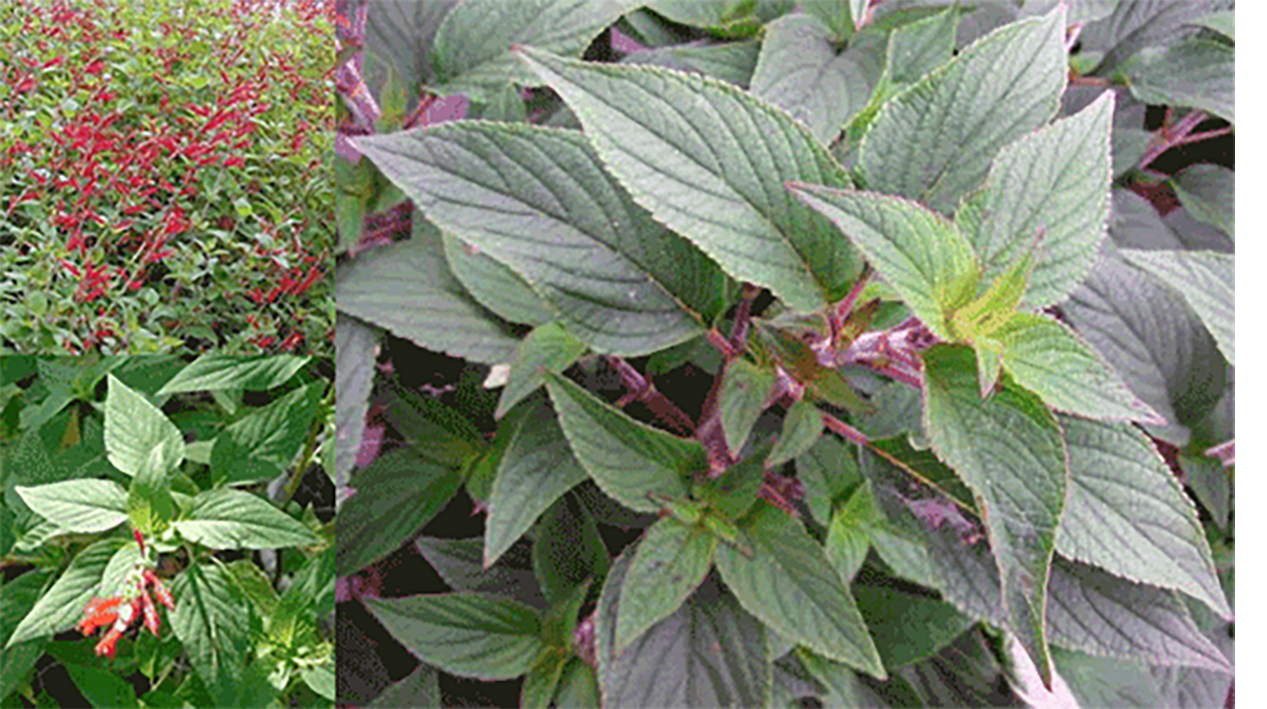 Pineapple Sage,
Salvia
elegans, plant
in flower, close up
of leaves.
Pineapple Sage,
Salvia
elegans, plant
in flower, close up
of leaves.
Welcome to the summary page for FabulousFusionFood's Herb guide to Pineapple Sage along with all the Pineapple Sage containing recipes presented on this site, with 1 recipes in total.
e This is a continuation of an entire series of pages that will, I hope, allow my visitors to better navigate this site. As well as displaying recipes by name, country and region of origin I am now planning a whole series of pages where recipes can be located by meal type and main ingredient. This page gives a listing of all the Cornish recipes added to this site.
These recipes, all contain Pineapple Sage as a major herb flavouring.
Pineapple sage, Salvia elegans (also known as Pineapple Scented Sage) is a perennial flowering semi-woody subshrub that's a member of the Lamiaceae (mint family). The plant is native to oak and pine forests in the highlands of Mexico. Pineapple sage is a tender perennial, growing some 70cm tall and 60cm wide. The leaves are bright green, occur in opposed pairs and are more pointed than other sages. They are soft, fleshy and fuzzy to the touch, with pronounced veining underneath and serrated margins. They become tinged with red as they age. Bruising the leaf yields an intense, sweet, pineapple-like fragrance. The flowers are tiny, deep-throated, tubular, two-lipped and scarlet or ruby red in colour that are borne on slender green stalks and typically develop in late summer. These are edible and have a tangy, citrus-mint flavour. When fertilized the flowers develop tiny, dark brown, ovoid seeds. The plant's stems are square in cross-section and turn woody after the second year.
Being tender, the plant requires temperatures above -1°C. Though, as long as winters are mild the plant root can survive if heavily covered with mulch or turf. In colder climes, however, it's best to over-winter the plant indoors before the first heavy frosts. The plant can also be grown as an annual.
The leaves of pineapple sage make an excellent herb and can be used in both sweet and savory dishes (they work particularly well with pork, chicken and cheese). Like common sage, the flavour of pineapple sage leaves intensify as they are dried, but the fleshiness of the leaves means that they need to be dried carefully or they will turn mouldy). Pineapple sage can be substituted in any recipe calling for basil. It also pairs well with desserts and can be substituted in any recipe calling for lemon verbena.
e This is a continuation of an entire series of pages that will, I hope, allow my visitors to better navigate this site. As well as displaying recipes by name, country and region of origin I am now planning a whole series of pages where recipes can be located by meal type and main ingredient. This page gives a listing of all the Cornish recipes added to this site.
These recipes, all contain Pineapple Sage as a major herb flavouring.
Pineapple sage, Salvia elegans (also known as Pineapple Scented Sage) is a perennial flowering semi-woody subshrub that's a member of the Lamiaceae (mint family). The plant is native to oak and pine forests in the highlands of Mexico. Pineapple sage is a tender perennial, growing some 70cm tall and 60cm wide. The leaves are bright green, occur in opposed pairs and are more pointed than other sages. They are soft, fleshy and fuzzy to the touch, with pronounced veining underneath and serrated margins. They become tinged with red as they age. Bruising the leaf yields an intense, sweet, pineapple-like fragrance. The flowers are tiny, deep-throated, tubular, two-lipped and scarlet or ruby red in colour that are borne on slender green stalks and typically develop in late summer. These are edible and have a tangy, citrus-mint flavour. When fertilized the flowers develop tiny, dark brown, ovoid seeds. The plant's stems are square in cross-section and turn woody after the second year.
Being tender, the plant requires temperatures above -1°C. Though, as long as winters are mild the plant root can survive if heavily covered with mulch or turf. In colder climes, however, it's best to over-winter the plant indoors before the first heavy frosts. The plant can also be grown as an annual.
The leaves of pineapple sage make an excellent herb and can be used in both sweet and savory dishes (they work particularly well with pork, chicken and cheese). Like common sage, the flavour of pineapple sage leaves intensify as they are dried, but the fleshiness of the leaves means that they need to be dried carefully or they will turn mouldy). Pineapple sage can be substituted in any recipe calling for basil. It also pairs well with desserts and can be substituted in any recipe calling for lemon verbena.
The alphabetical list of all Pineapple Sage recipes on this site follows, (limited to 100 recipes per page). There are 1 recipes in total:
Page 1 of 1
| Pineapple Sage Pound Cake Origin: American |
Page 1 of 1